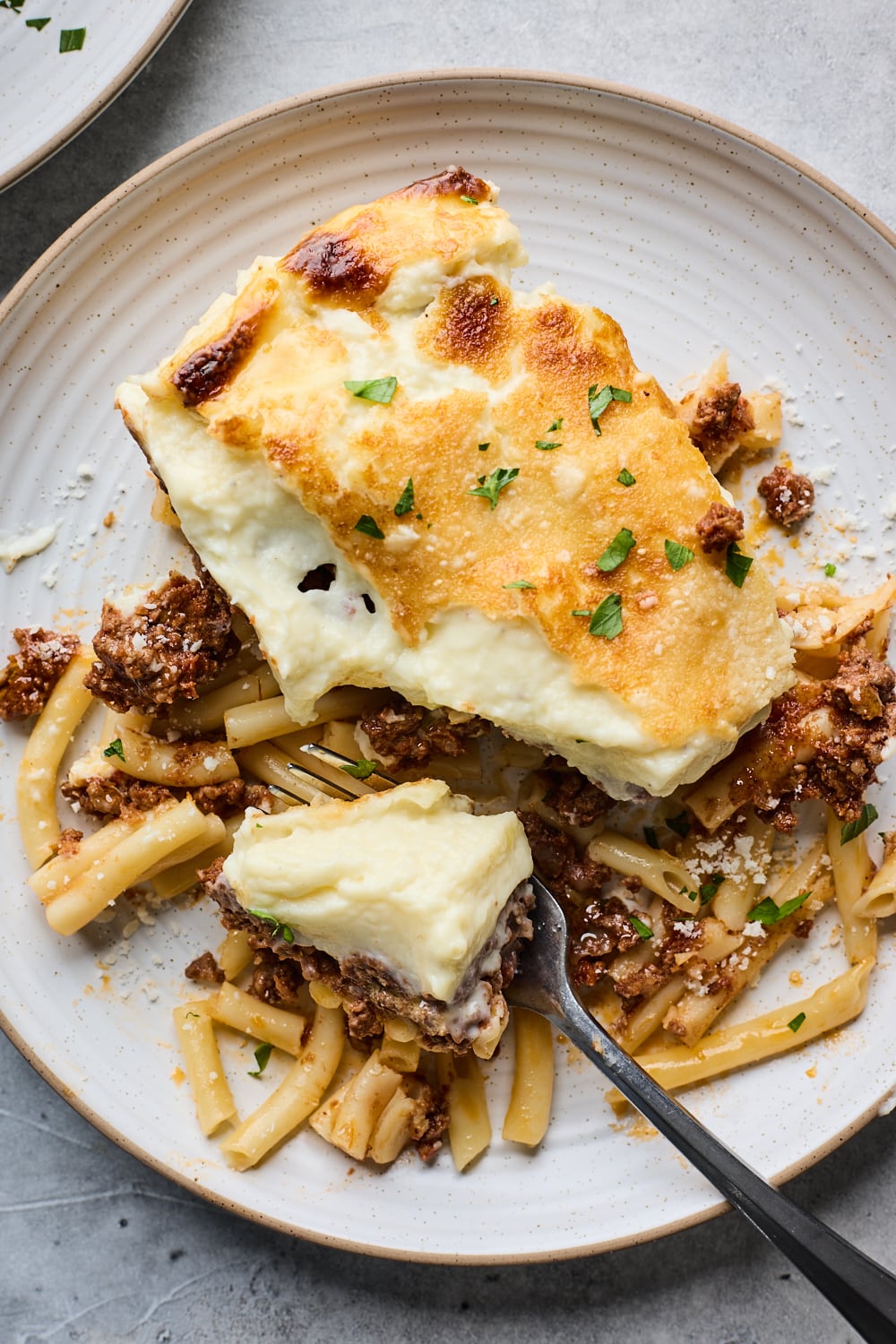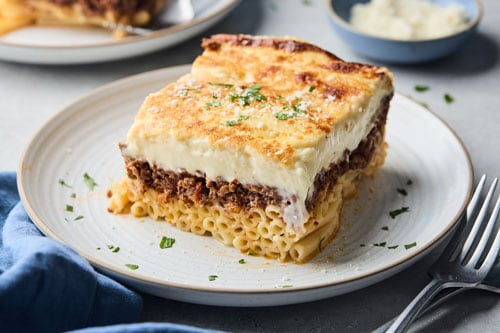Pastitsio (Greek Lasagna)
This Greek pastitsio recipe is my favourite - I have made many versions but I keep coming back to this one because it turns our perfectly every time also the bechamel to meat sauce and pasta ratio is pure perfection in my opinion and I think many feel the same way. The ratio is really what makes or breaks a pastitsio recipe or a moussaka recipe because you want a nice bit of creamy bechamel in every bite along with enough meat sauce and pasta in each bite. This recipe delivers on each of those things plus this is a great make-ahead recipe either the whole pastitsio or making ahead portions of it a day in advance which helps you put it together in a jiffy the day you want to actually get it in the oven - this is what makes this recipe so easy too! This makes enough pastitsio to feed a small army but I made the recipe so that you can easily downsize it to half for a more “normal” portion. But I say the bigger the portion the better for leftovers and freezing! I’m going to breakdown each different components to note any variations, substitutions, directions & tips for each part of the pastitsio - so let’s go!
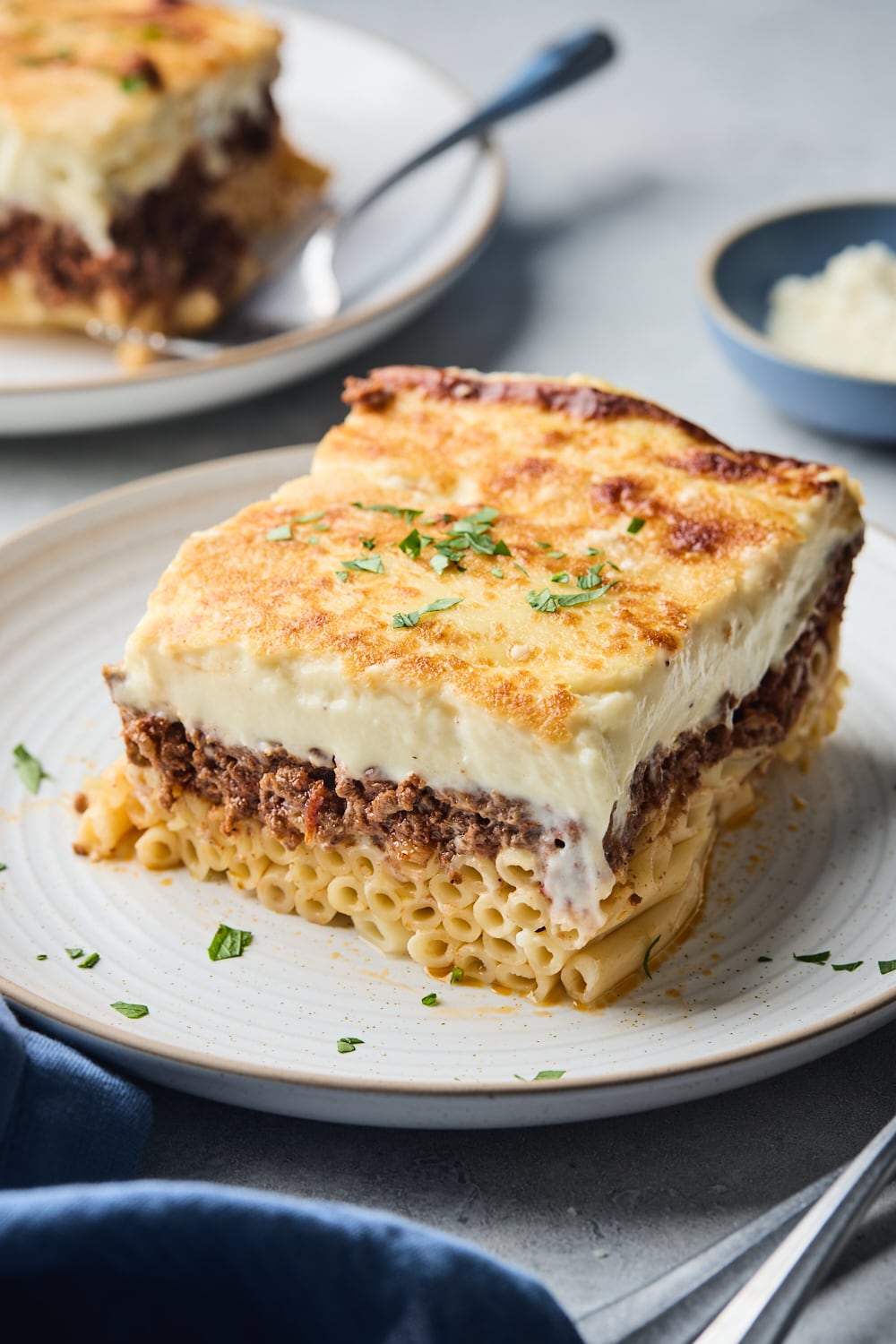
What is Pastitsio?
Pastitsio is a a Greek pasta bake - classic pasta and meat sauce casserole or casserole dish - many refer to it as a Greek lasagna with layers of pasta, a warmly spiced meat sauce and a third layer made of a creamy bechamel sauce or creamy cheese sauce. Typically pastitsio is made with long hollow noodles called Bucatini pasta No2. That is always the thickness I have used and my mom has used in her pastitsio. It is Greek comfort food at its best. If you already love our Makaronia Me Kima (Greek pasta with meat sauce) well this takes it to the next level with the creamy layer of bechamel. What’s the difference between pastitsio and moussaka? That is a very common question - they share 3 commonalities:
- They are both layered casseroles.
- They both have a layer of Greek meat sauce
- They are both topped off with a nice thick layer of béchamel.
Pastitsio as I mentioned is a pasta based casserole dish and moussaka has layers of roasted or fried vegetables instead of pasta using potatoes and eggplants. Lets breakdown each layer of this pastitsio shall we…
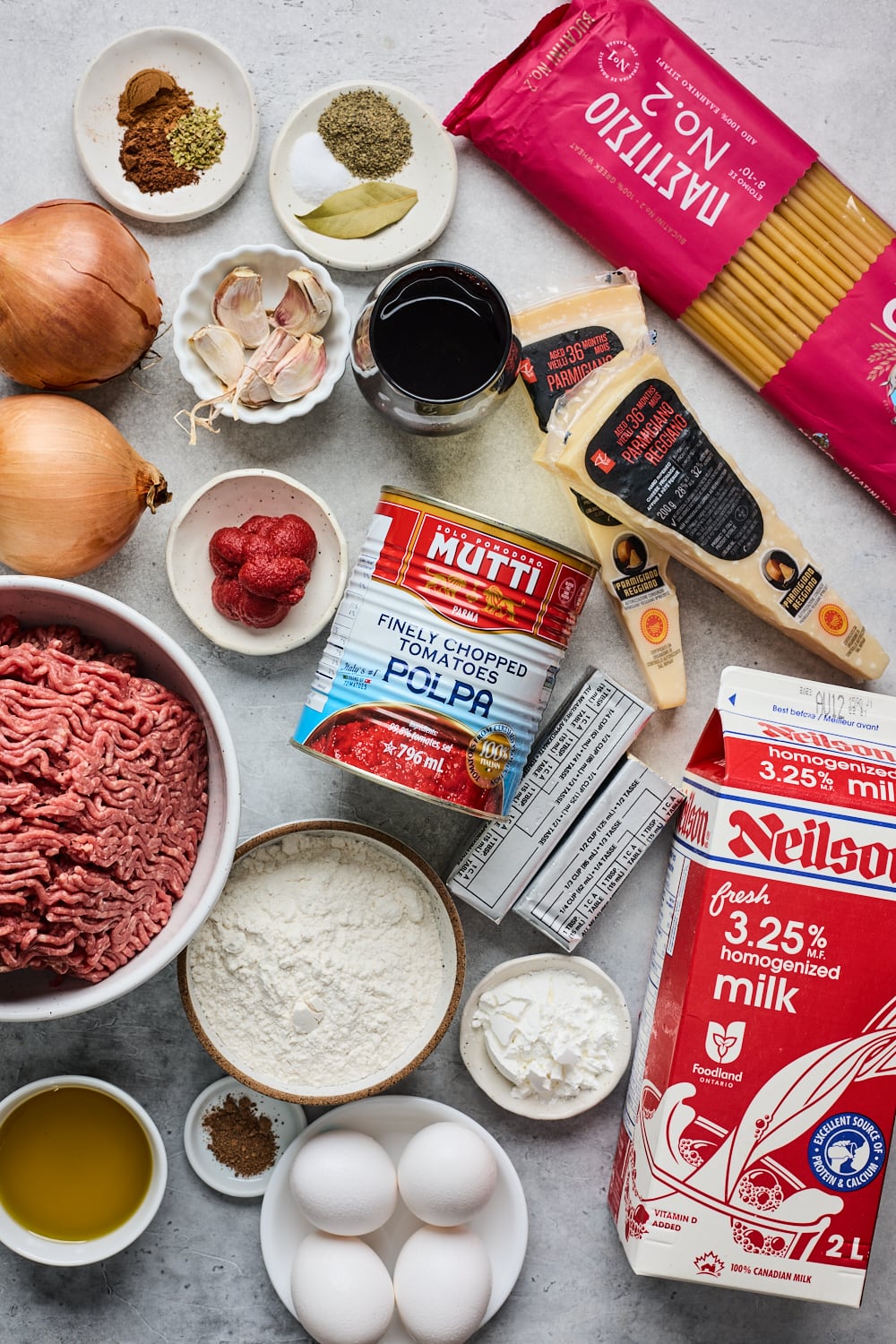
Pasta for the Pastitsio (1st layer)
Ingredients for the Pastitsio Noodles/Pasta Layer
- BUCATINI PASTS NO2: If you cannot find this type of pasta you want to chose a pasta that has the same or similar hollow size or thickness - penne pasta is usually the best option because it tends to be very similar in size but certain rigatoni will work as well. If you can keep the size or width the same you dont really need to adjust the amount of pasta needed - for example I would not recommend using elbow macaroni for the base
- BUTTER: Butter is used to toss the pasta with after you drain the pasta. Not only does it flavour the pasta but it prevents the pasta from sticking while you are preparing the rest of the ingredients. I always use butter for really rich flavour but feel free to use olive oil
- CHEESE: You will need 1 cup of finely grated cheese for dusting the pasta with. Typically pastitsio is made using Greek Cheese - Greek Kefalotiri/kefalotyri cheese, or Kaseri but if you cannot get this kind of cheese feel free to use Parmigiano Reggiano (Parmesan cheese) or Romano cheese.
Pasta Layer Instructions and tips
- Simply cook pasta in a large pot of salted water according to package directions until al dente. Drain pasta well and do not rinse.
- In the same pot you boiled the pasta, melt butter and return drained pasta into pot and toss well with butter
- Pour pasta into prepared pan. You can either do this by organizing and placing all the long pasta strands in the pan in the same direction so that you get all of them facing symmetrically which I did for the pictures alone. Usually I will pour in the pasta and just ensure it’s all in an even layer in the pan just as the strands land. This is totally up to you and how much time you have on your hands and how aesthetic you want your pieces to look.
Some recipes call for tossing the pasta with a couple of the eggs whites (remaining from the yolks) which will act sort of like glue so that the noodles stick together. Personally I don’t like doing that - I find it could create some egginess in flavor so I avoid doing that. If I want the same effect what I usually do is toss the noodles with some of the bechamel sauce which will sort of do the same thing. I usually don’t toss them in any thing but the butter or olive oil and simply sprinkle the grated cheese over them to separate layers. I really don’t mind loose noodles - but the bechamel and sauce tends to seep through a little helping hold everything together naturally
MAKE AHEAD: The pasta cooks so quickly so there really is no need to make this step of the pastitsio ahead of time.
For The Meat Sauce (2nd layer)
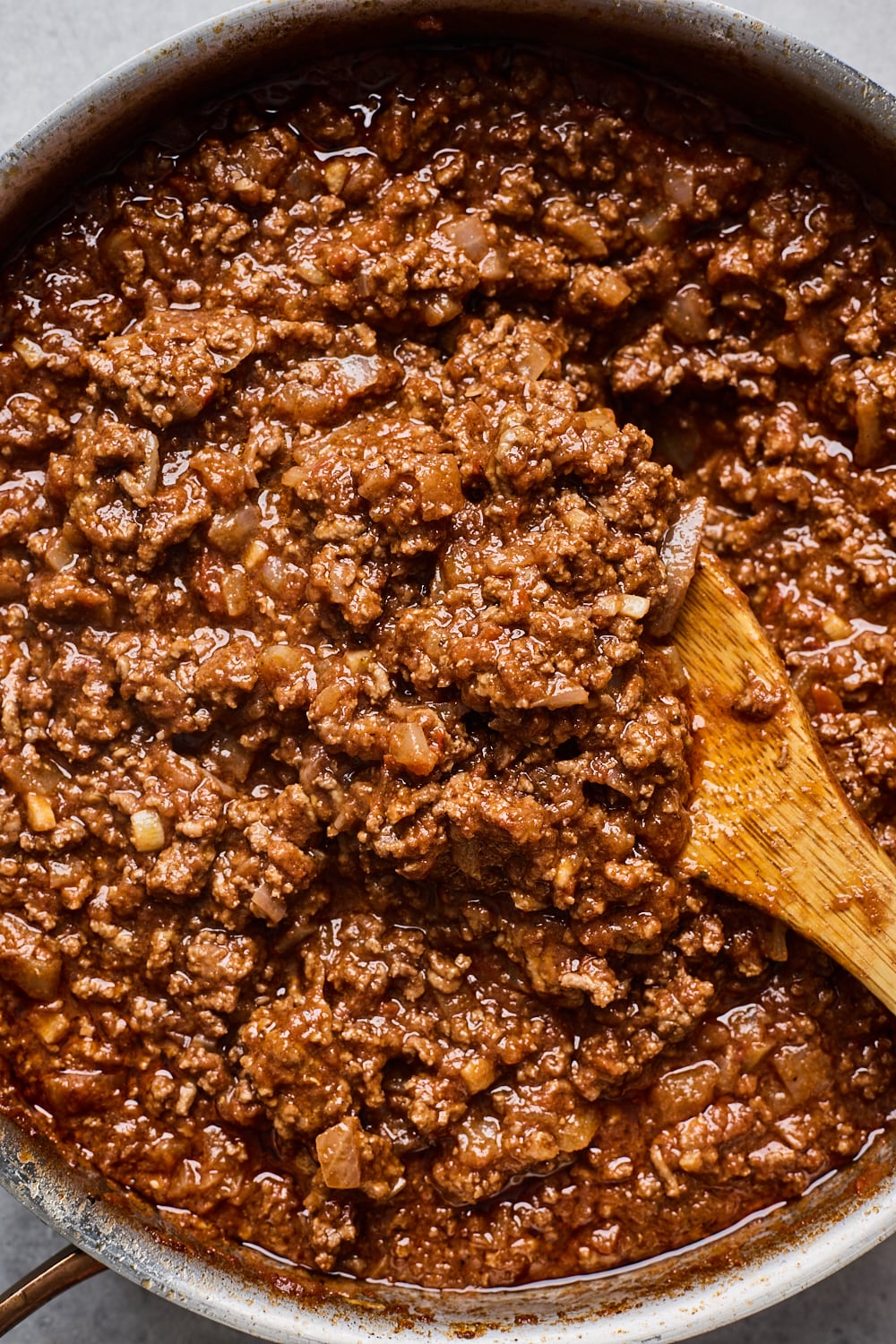
The meat sauce for the pastitsio is very similar to my meat sauce for Makaronia Me Kima - or my Greek pasta with meat sauce. The same flavours spices and herbs are used to give it that signature Greek meat sauce flavour. The sauce needs to be thick enough and not too wet or saucy so I let my sauce simmer for a good 30-45 minutes so that the flavours are richer and the sauce is thicker.
Ingredients for Meat Sauce
- OLIVE OIL: I use extra virgin olive oil to saute the onion, garlic and meat
- ONION & GARLIC: I usually use a yellow onion but white onion or red onion is fine to use as well. Use as much or as little garlic as you prefer
- BEEF: I use lean ground beef for the meat sauce but you can also make this with any other ground meat including ground lamb or a combination of pork and beef.
- TOMATO PASTE & CRUSHED TOMATOES: Tomato paste adds richness to the tomato sauce and I use finely minced canned tomatoes, usually Mutti, because I love the texture it gives my sauce but any decent quality crushed tomatoes will work here
- WINE: I always love to add a splash or two of red wine in my meat sauce to help deglaze the pan and add flavour. This is optional and no need to replace it with anything if leaving it out - simply add in the crushed tomatoes and remaining ingredients.
- HERBS & SPICES: Apart from the salt and pepper used to season it to taste, the meat sauce is typically seasoned with dried oregano, ground cinnamon (signature spice in Greek Meat Sauce), ground clove and bay leaf. Feel free to adjust amounts to taste. And feel free to add some chili flakes or paprika for a hint of smokiness or extra flavour.
- CHEESE: Typically pastitsio is made using Greek Cheese - Greek Kefalotiri/kefalotyri cheese, or Kaseri but if you cannot get this kind of cheese feel free to use Parmigiano Reggiano (Parmesan cheese) or Romano cheese. You will need 1 cup for for dusting the sauce with
- EXTRA ADD INS: Feel free to add more veggies to your meat sauce like minced carrots and celery for a mirepoix or add in some finely chopped red bell pepper for even more flavour. Simply sauté these veggies along with the onion and garlic until they start to soften. Feel free to add in other spices to the sauce according to taste or spice it up with chili flakes or cayenne pepper.
Meat Sauce Instructions
- Sauté the onion and garlic in a skillet or medium saucepan over medium heat or medium high heat until onion is softened then add the beef to pan and sauté breaking it apart until well browned.
- Stir in tomato paste into meat mixture then deglaze pan with wine if using simmering until it’s reduced.
- Stir in remaining sauce ingredients and simmer sauce until thickened then remove from heat and allow to cool.
Meat Sauce TIPS: Cool meat sauce. A cool meat sauce will help keep layers more distinct and separate - the cheese in-between each layer helps too. A thick and room temperature sauce sits on top of the pasta instead of running through the pasta - some of it still will but most of it will stay in a layer above it providing a great bed for the bechamel layer above it.
MAKE AHEAD: Meat sauce can be made up to 2 days ahead and stored in the fridge in an airtight container. Make sure to allow sauce to come to room temperature before chilling. The meat sauce can also be frozen for at least a month after it has been cooked and cooled and packed in airtight container. If you are freezing it just thaw completely in the fridge overnight then use as directed in the recipe.
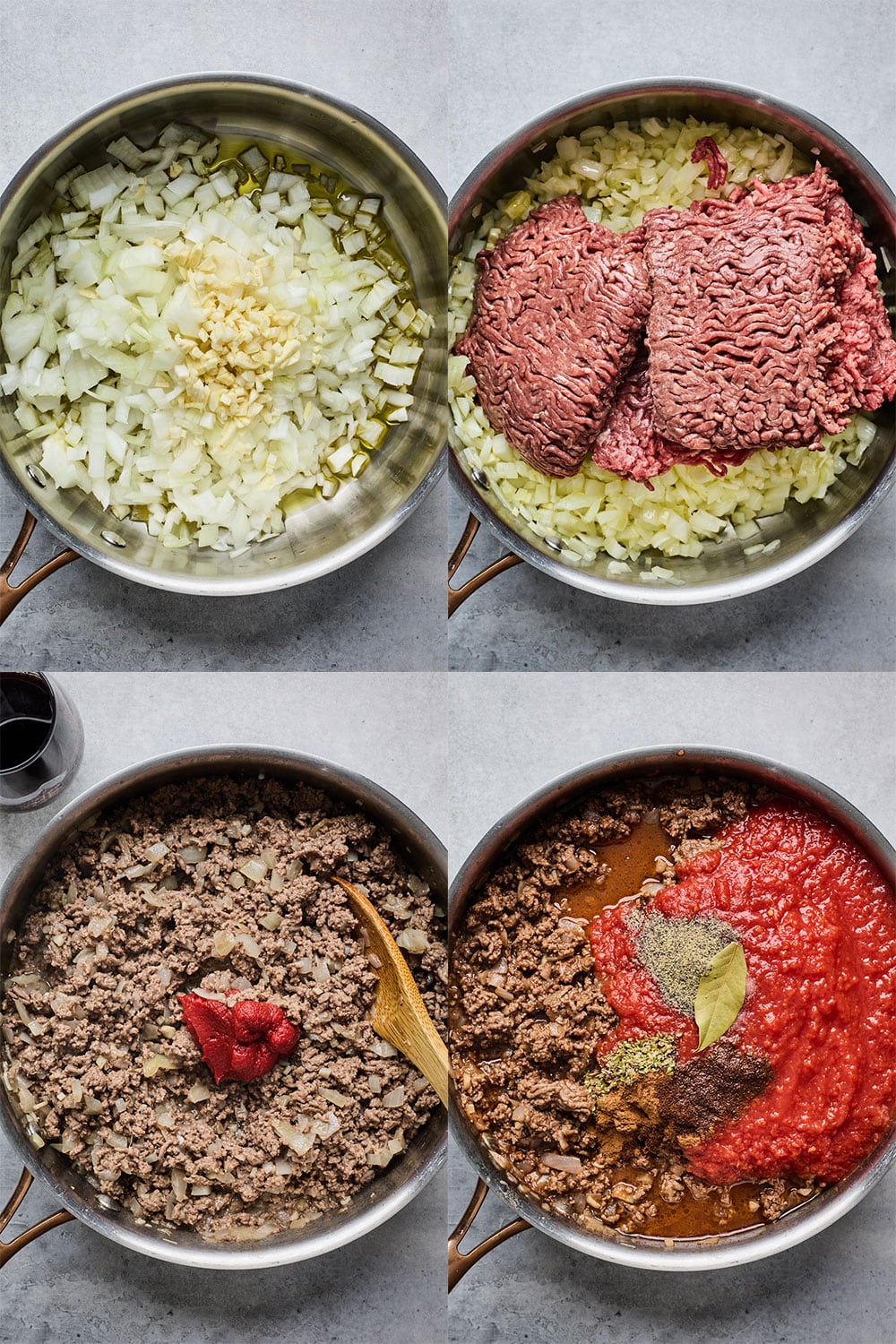
The Creamy Béchamel Sauce (3rd layer - top)
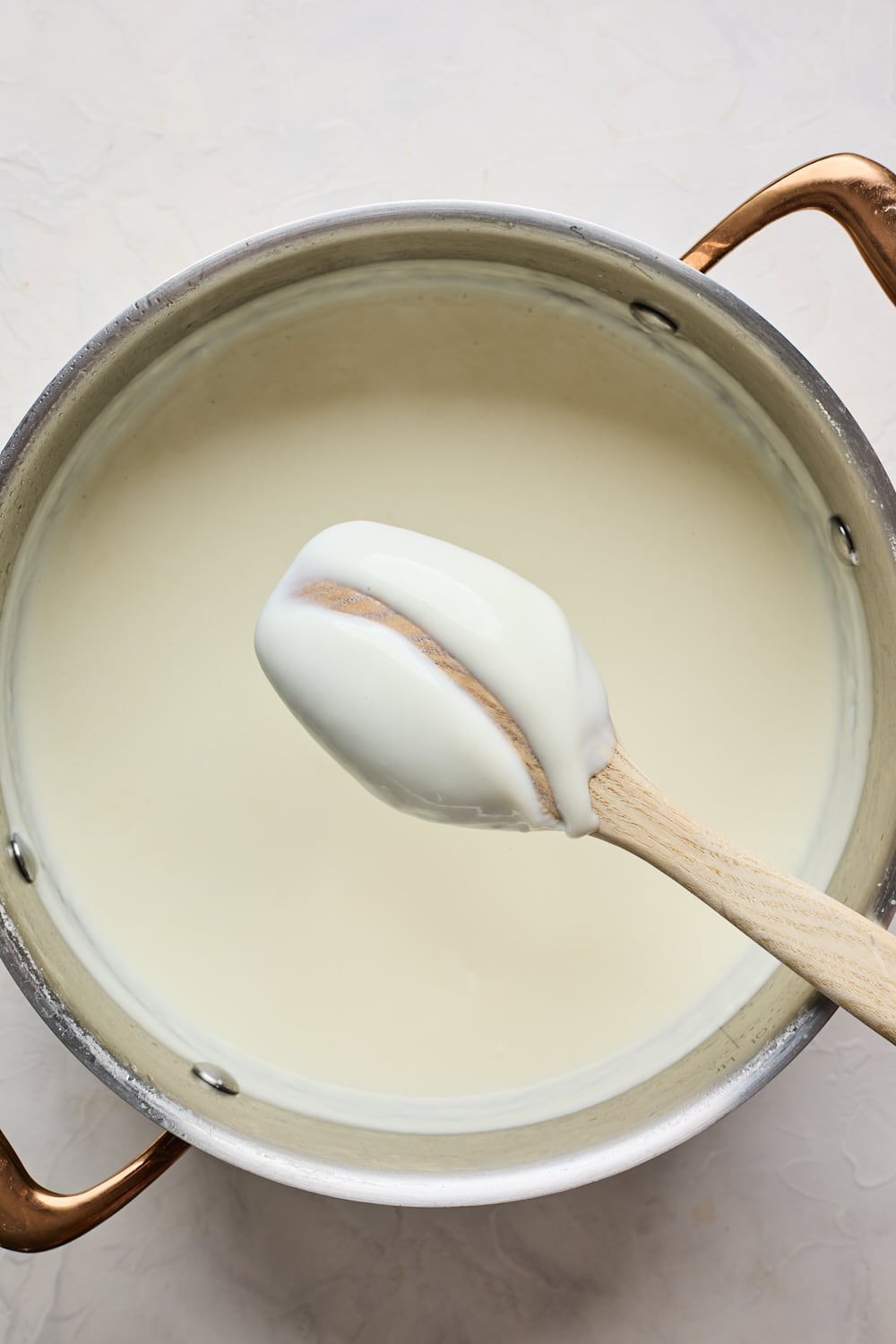 The creamy bechamel layer is basically the piece de resistance of the whole dish if you ask me or any Greek person. Whether you like yours runny or thicker it really is the best part. I like mine to be a nice thick layer over the meat layer so to be able to create that layer not only do I make more sauce but I also make sure to allow the pastitsio to sit a little while after baking so that the sauce and the whole pastitsio has time to set properly otherwise when you cut into the pastitsio the top layer will be too runny. Some people prefer there’s that way and that is fine. Don’t be intimidated to make bechamel sauce- it’s quite easy to make. All you need is a little patience and the will to whisk and that is all. There’s a not so secret ingredient I like to add - corn starch which helps with the setting process. It helps the bechamel sauce layer set nicely without being too stiff - the sauce sets but is still super creamy. The egg yolks add richness to the bechamel but also help it set. Some people like to add the eggs in whole to help it set but I find the egg whites can sometimes give your sauce a bit of an eggy flavor - so I stick with the yolks alone and the cornstarch. It makes for a perfect creamy bechamel layer. Here is what you will need:
The creamy bechamel layer is basically the piece de resistance of the whole dish if you ask me or any Greek person. Whether you like yours runny or thicker it really is the best part. I like mine to be a nice thick layer over the meat layer so to be able to create that layer not only do I make more sauce but I also make sure to allow the pastitsio to sit a little while after baking so that the sauce and the whole pastitsio has time to set properly otherwise when you cut into the pastitsio the top layer will be too runny. Some people prefer there’s that way and that is fine. Don’t be intimidated to make bechamel sauce- it’s quite easy to make. All you need is a little patience and the will to whisk and that is all. There’s a not so secret ingredient I like to add - corn starch which helps with the setting process. It helps the bechamel sauce layer set nicely without being too stiff - the sauce sets but is still super creamy. The egg yolks add richness to the bechamel but also help it set. Some people like to add the eggs in whole to help it set but I find the egg whites can sometimes give your sauce a bit of an eggy flavor - so I stick with the yolks alone and the cornstarch. It makes for a perfect creamy bechamel layer. Here is what you will need:
Bechamel Sauce Ingredients
- BUTTER: Unsalted butter is what I use and it builds the flavours in the sauce.
- FLOUR: All purpose flour is what I use - a gluten free 1-1 flour will work but no guarantees that the texture will be the same as gluten-free flours are usually blended with other types of thickeners and additives that could affect the texture of the bechamel sauce
- CORNSTARCH: This helps thicken the sauce and helps its set well while keeping its super creamy texture
- MILK: I use whole milk and recommend it for best flavour and texture. It will give you a nice rich bechamel sauce which is what you want in a good pastitsio
- EGG YOLKS: As I mentioned above I usually use just the yolks for the pastitsio because they add richness without the egg flavour. If you prefer to use the whole eggs that is fine but the flavour may be affected slightly and so will the texture as the whites tend to tighten up the mixture quite a bit.
- CHEESE: Typically pastitsio is made using Greek Cheese - Greek Kefalotiri, or Kaseri but if you cannot get this kind of cheese feel free to use Parmigiano Reggiano (Parmesan cheese) or Romano cheese. You will need 2 cups divided for the bechamel. 1 cup will get whisked in and the other dusted over the sauce in the pan
- NUTMEG: A little nutmeg adds just that hint of flavour that you expect in a bechamel sauce - if you are really not a fan just leave it out.
Bechamel Sauce Instructions
- Combine flour and cornstarch
- Melt butter then whisk in flour mixture and cook stirring 1 min
- Slowly drizzle in milk while whisking
- Cook mixture whisking until thickened
- Remove from heat and whisk in cheese, nutmeg and season with salt rotate
- Vigorously whisk in the egg yolks
Tips for Making Great Bechamel Sauce Every time
- Whisk continuously: Don’t walk away from the stove when you are cooking béchamel - the milk can stick to the bottom of the pan easily and burn affecting the flavour of the whole sauce
- Go easy on the Heat: Don’t be tempted to increase the temperature to cook the sauce faster - this willingly increase your chance of burning the sauce. Medium to medium high is quite enough to help simmer and cook the sauce
- Milk should be room temperature: Having it room temperature at the very least is recommended or you can even warm it up so that it really mixes in well with the roux - butter flour cornstarch mixture
- Add the milk slowly: This will help the roux loosen up and become nice and smooth instead of clumping up
- Cook sauce long enough: Take your time with it - you want to make sure the sauce is nice and thick and coats a spoon really well when dipped into the sauce. This will ensure that the sauce will set well also. Once the spoon is coated you can make sure it’s ready by running your finger across the coated spoon. If your finger clears a path on the back of the spoon, the sauce is thick enough, but if it runs back in to the fill the space, it needs a little longer. Another sign that your bechamel sauce is thick enough is when you whisk it the whisk leaves marks behind in the sauce - yes you want it pretty thick
MAKE AHEAD: Bechamel sauce will also keep in the fridge in an airtight container for up to five days, but I usually make it the day before. It can also be frozen for up to three months, (when thawed it may look grainy but reheat gently over low heat stove top and it will smooth out.)
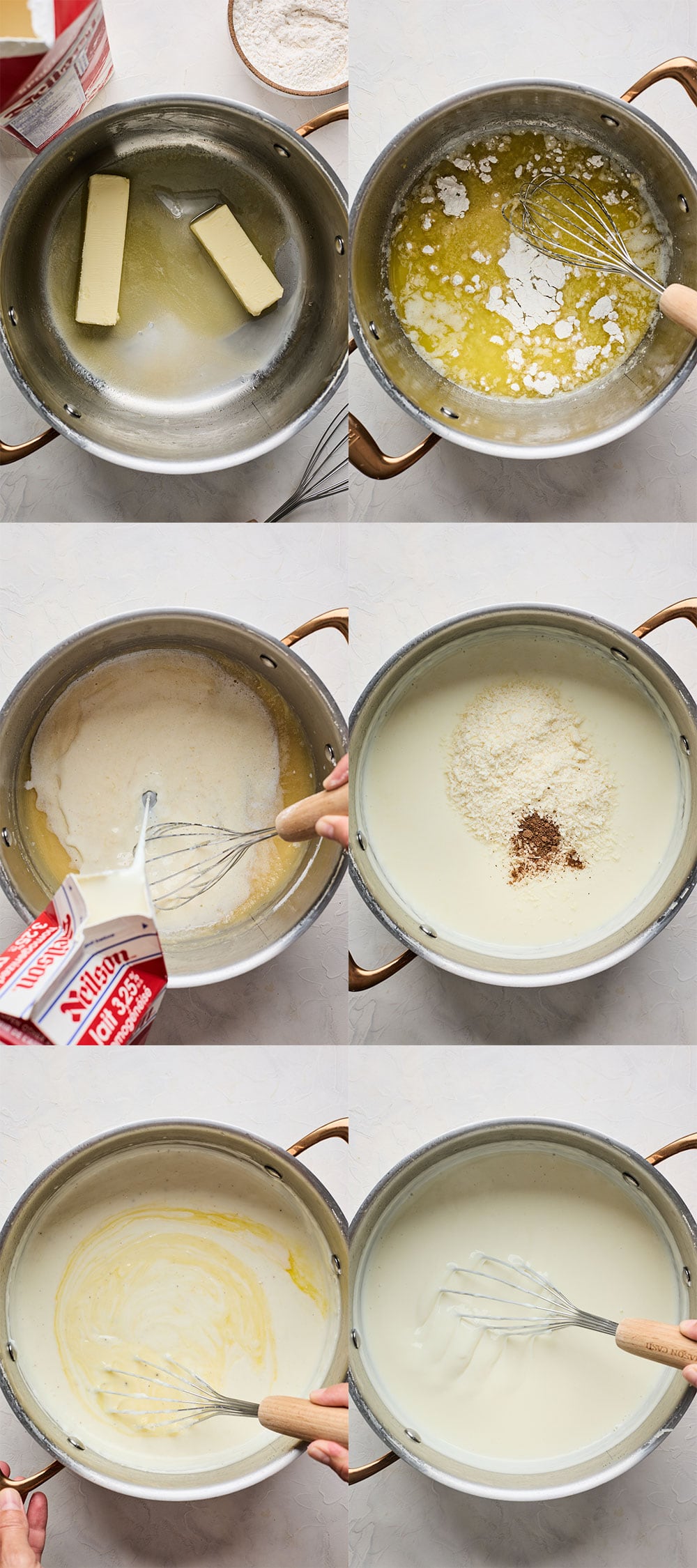
Assembling & Baking Your Pastitsio
Now that you have made all three components of your pastitsio it’s time to assemble it. There are many variations on layering this dish but this is how I have always made mine:
- PLACE pasta in pan in and even layer - top with cheese
- SPOON over all the meat sauce evenly over pasta - top with cheese
- POUR over béchamel sauce evenly over meat sauce - top with remaining cheese
- BAKE uncovered
- REST: Once out the oven allow time for pastitsio and bechamel to set and rest so it’s less messy to slice (waiting is the hardest part but worth it). You will need to let it rest for 1 hour
- SLICE & SERVE
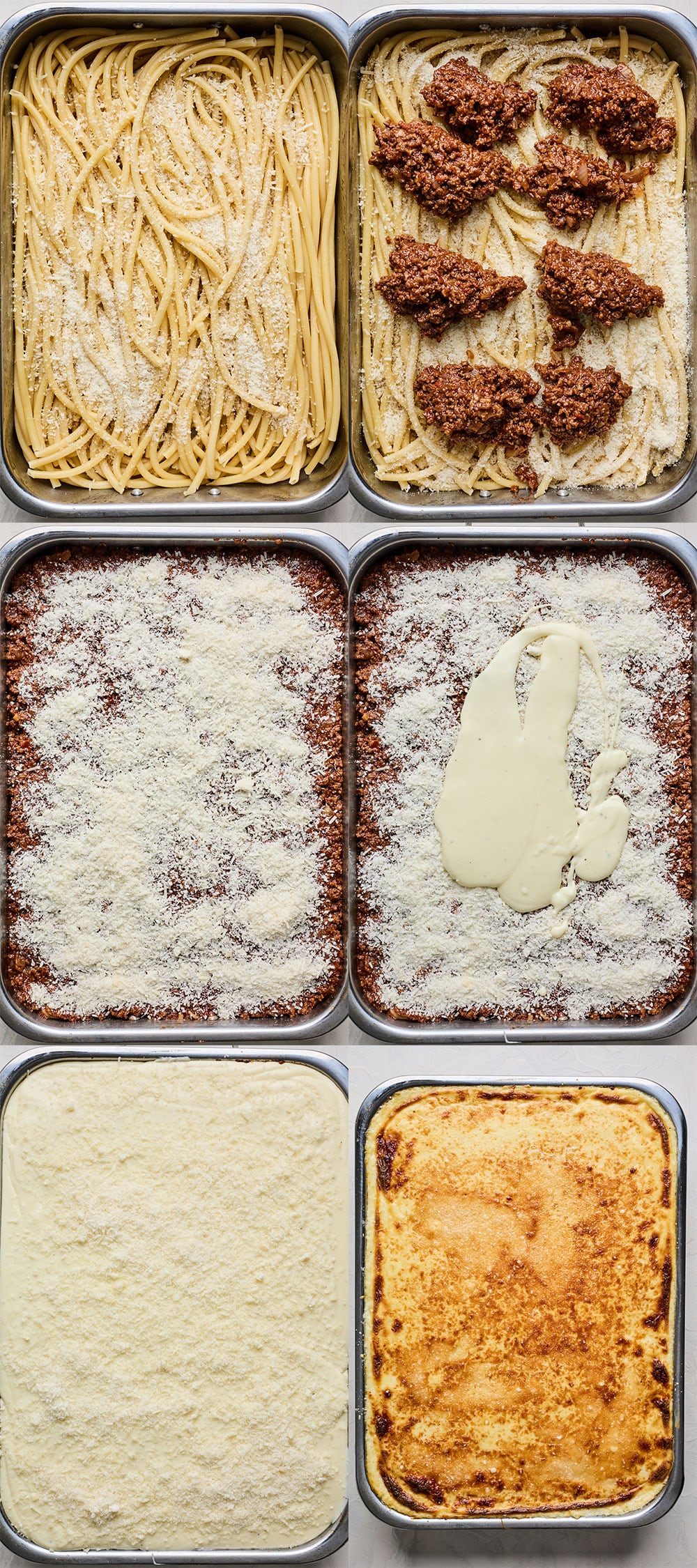
Pastitsio Make-Ahead, Storage and Freezing Instructions:
- BAKE NOW: Prepare recipe fully and then let it cool before covering it and storing it in the fridge for up to 3 days before you plan on serving it. To reheat it set the oven to 350º F and heat the casserole for 10 to 15 minutes or until heated through.
- BAKE LATER: Prepare recipe up to just the point of baking it and then cover it tightly with plastic wrap and refrigerate for up to 1-2 days in advance of when you plan on baking it. Before baking the casserole let it sit at room temperature for 30 minutes while preheating the oven.
- STORAGE: Any leftovers can be placed in the fridge and stored in and sit tight container for up to 3-5 days. Reheat in the microwave or in the oven
- FREEZING: Cool pastitsio completely before freezing. Cover in plastic wrap and layer of foil and freeze for up to 4 months. You can also portion it out into individual servings sealed in an airtight container. Let the whole casserole or individual pieces thaw overnight in the fridge and then reheat it in the microwave or oven.
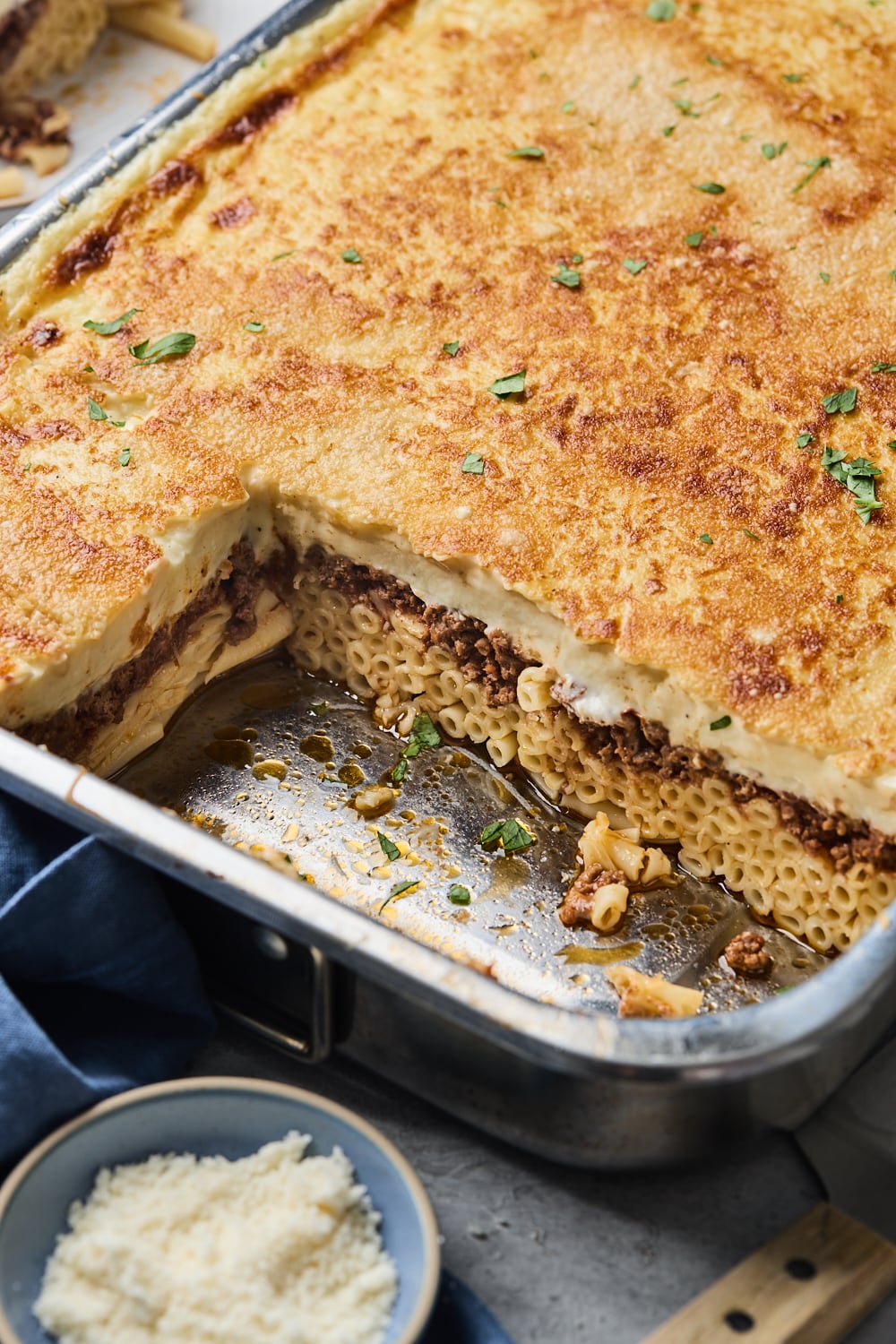
What To Serve Pastitsio With
You really can serve this dish with just about anything on the side. Lately pastitsio has been my staple dish and go to for having company. This is just the right size for a group of 10-12 people. I typically make my roasted red pepper feta dip as an appetizer with pita chips and serve the pastitsio with a huge Greek salad, my grilled vegetables and I also make Greek Baked beans with it or Gigantes. For dessert I make my Karithopita or Greek Walnut cake but here are some other great Greek style sides that would also be delicious:
- Greek Green Beans (fasolakia yiahni)
- Greek Asparagus Salad
- Greek Cucumber Salad
- Classic Greek Lettuce Salad (Maroulosalata)
- Greek Style Green Bean Salad
- Greekstyle Kale Caesar Salad
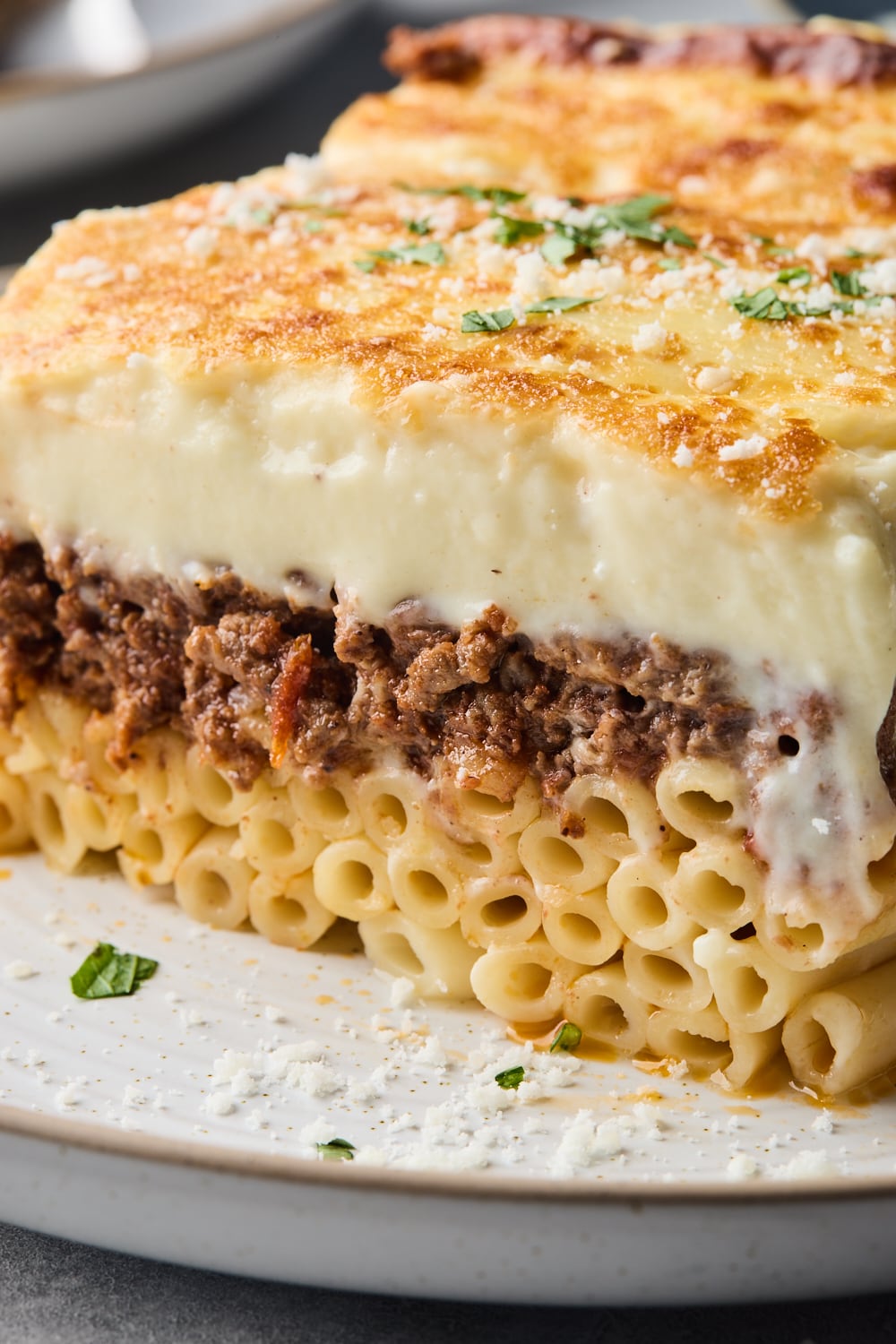
More Greek Recipes You Will Love:
Recipe
Ingredients
For the Meat Sauce
- 2 tablespoons olive oil
- 2 onions, peeled and diced
- 4 garlic cloves, peeled and minced
- 2-2½ lbs ground beef (lean)
- 2 tablespoons tomato paste
- ½ cup red wine
- 28 oz can crushed tomatoes (I use Mutti Finley minced tomatoes)
- 1 bay leaf
- ½ teaspoon ground cinnamon
- ¼ teaspoon ground cloves
- ¼ teaspoon dried oregano
- ¾ teaspoon salt
- 1 teaspoon black pepper
- 1 cup finely grated cheese (Kefaloturi or Kaseri, Parmesan or Romano cheese)
For the Bechamel Sauce
- 1¾ sticks of unsalted butter
- 1 cup All-purpose flour
- 2 heaping tablespoons of Cornstarch
- 2 cups finely grated cheese, divided (Kefaloturi , Kaseri, Parmesan or Romano cheese)
- 4 large egg yolks, room temperature
- 2 Litres whole milk, room temperature
- ¼ teaspoon ground nutmeg
For the Pasta
- 500g Bucatini pasta No2
- 2 tablespoons unsalted butter
- 1 cup grated cheese (Kefaloturi , Kaseri, Parmesan or Romano cheese)
Directions
For the Meat Sauce
- Heat a large Dutch oven or large skillet over medium heat or medium high heat. Add onion and garlic and cook for 2-3 minutes until onion is softened and is translucent. Add beef and cook, breaking it up as you go, until browned.
- Stir in the tomato paste and cook 1 minute
- Add wine and and cook until the wine has mostly evaporated - about 3 minutes.
- Add remaining Meat Sauce ingredients: Tomatoes, spices, herbs, bay leaf and salt and pepper. Stir well, bring to boil, then reduce heat to medium / medium low and continue to simmer, cooking sauce for 30-45 or until sauce is nice and thick and liquid has reduced, stirring It occasionally
- Remove from heat and set aside to cool. Preferably to room temperature, otherwise for at least 30 minutes before assembling. Meat sauce can be made up to 2 days ahead and stored in the fridge
For the Creamy Bechamel
- Whisk together the flour and cornstarch to combine then set aside
- Melt the butter in a large saucepan over medium heat - medium-high heat and add in the flour mixture and whisk to combine and cook for 1-2 minutes, you will have a thick paste.
- Gradually drizzle in the milk while whisking continuously
- Continue to cook, whisking often/continoulsy (you don’t want the milk to burn) for 5 minutes or until thickened and can coat the back of a wooden spoon - you can easily draw a line through it with your fingers.
- Remove from heat. Stir in nutmeg, cheese and season with salt.
- Whisk in 4 egg yolks vigorously until fully combined into mixture. Cover pot with lid and set aside. TIP: If you are making bechamel ahead place a piece of plastic wrap right on top of the surface of the cream sauce to prevent skin from forming.
For the pasta
- Boil pasta until just Al dente, drain pasta well then place them back in the pot off the heat and add butter and toss noodles until butter is melted
Assembling Pastitsio
- Preheat oven to 350°F
- Transfer pasta evenly to the bottom of a large baking pan and sprinkle over 1 cup grated cheese (feel free to toss the noodles with ½ cup of bechamel sauce before sprinkling over cheese)
- Spoon over all the meat sauce evenly over the pasta then sprinkle with 1 cup of grated cheese
- Pour over bechamel sauce evenly over the meat sauce and sprinkle generously with remaining grated cheese
- Place baking dish in the oven and bake for 45 minutes uncovered or until deeply golden and bechamel is mostly set and not runny (do a knife test or tooth pick test - stick toothpick into the top layer and if the sauce is still runny continue baking for another 10-15 minutes. Tent top with foil if it’s getting too brown too quickly at this point. If the sauce clings to the toothpick or knife then it’s ready.)
- Once done remove baking dish from oven and allow it to rest fo at least 1 hour uncovered to allow the pastitsio to set otherwise the béchamel sauce will be runny and the dish will be a bit messy to slice and serve.
- Slice into portions and serve garnished with fresh parsley
Recipe Notes
For tips and details about each layer and ingredient of this pastitsio please read blogs post above. Some people like to add feta cheese to the sauce or pastitsio but I typically do not but if you would like to toss the pasta with some or over the meat sauce feel free to.
Pastitsio Make-Ahead, Storage and Freezing Instructions:
- BAKE NOW: Prepare recipe fully and then let it cool before covering it and storing it in the fridge for up to 3 days before you plan on serving it. To reheat it set the oven to 350º F and heat the casserole for 10 to 15 minutes or until heated through.
- BAKE LATER: Prepare recipe up to just the point of baking it and then cover it tightly with plastic wrap and refrigerate for up to 1-2 days in advance of when you plan on baking it. Before baking the casserole let it sit at room temperature for 30 minutes while preheating the oven.
- STORAGE: Any leftovers can be placed in the fridge and stored for up to 5 days.
- FREEZING: Cool pastitsio completely before freezing. Cover in plastic wrap and layer of foil and freeze for up to 4 months. You can also portion it out into individual servings sealed in an airtight container. Let the whole casserole or individual pieces thaw overnight in the fridge and then reheat it in the microwave or oven.
